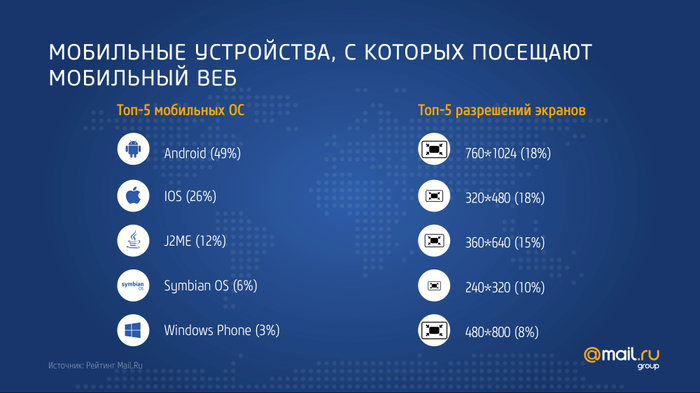One of the leaders of the Runet Mail.ru The Group and the world-renowned research company Nielsen Holdings N.V. conducted a joint analysis of the mobile industry in Russia and the world.
Alexander Gorny, Information Technology Director Mail.Ru Group, described a portrait of a typical Russian user of mobile devices. More than half of the users (53%) are men, whose average age is 19-30 years, and activity as a mobile device user increases from 22:00 to 00:00 on working days and, of course, on weekends. Most often they prefer Android-based devices (49%), iOS takes an honorable second place (26%).
Ekaterina Petrova, a Nielsen representative, said that most domestic users are limited to a standard set of services (sms, e-mail, web browser), mostly use only Wi-Fi and download freemium applications. In her opinion, for the development of the Russian mobile market, it is necessary to “train and educate the user in order to increase consumption and strengthen loyalty.”
Interestingly, over the past year, the number of mobile Internet users in Russia has increased by more than 50%. However, web specialists are not in a hurry to develop for their sites the ability to view through mobile applications. It is likely that such neglect negatively affects the breadth of the audience of web pages. 23% of web specialists are sure that visitors will immediately leave the site if it is not adapted for mobile devices.
Global trends in the development of the mobile industry were highlighted in his report by Matthew Hester, Director of Consumer Research at Nielsen Telecom Group in Europe. According to him, the average duration of smartphone use per day is about 80 minutes, while traditional calls take only 7 of them. Social networks occupy the first place in terms of the amount of time allocated to them – 24 minutes a day (30%). Applications are becoming increasingly popular (73%) to the detriment of normal browsing through the browser (11%).
Hester believes that the growth potential of the popularity of smartphones is still quite high. In developed countries, 50% of the population uses them, and in developing countries – only 15-20%. “Market players should invest in their infrastructure and services to be ready for new demand,” he stressed.

